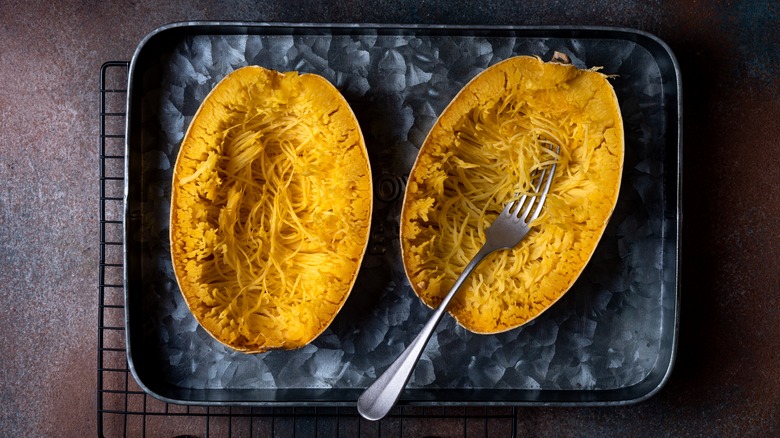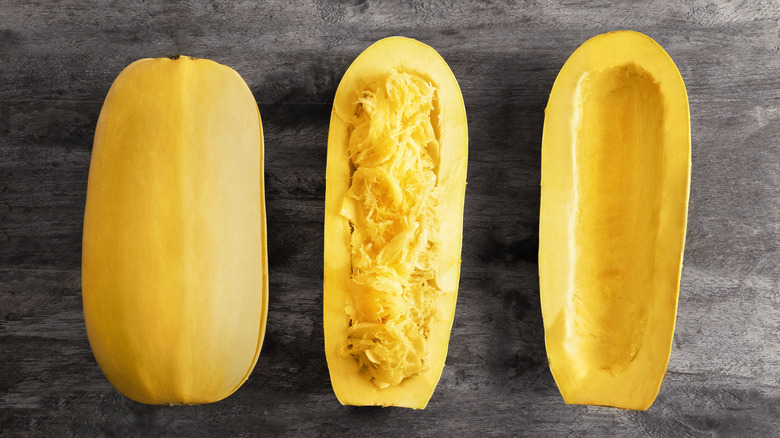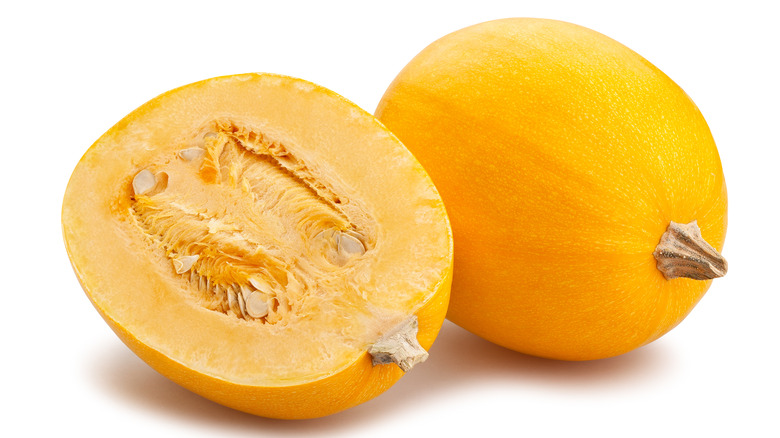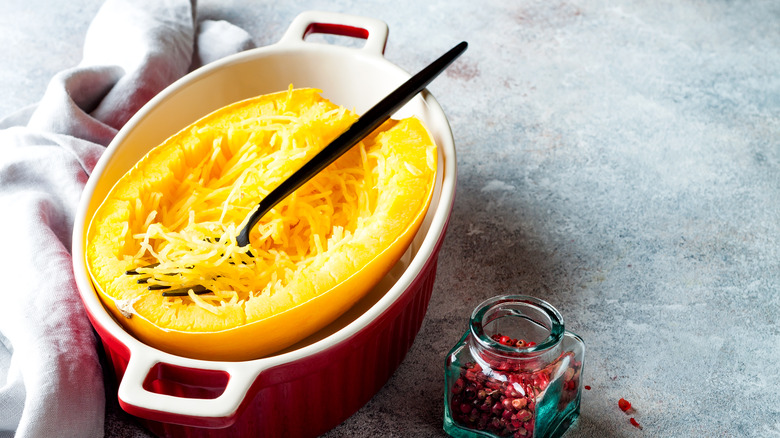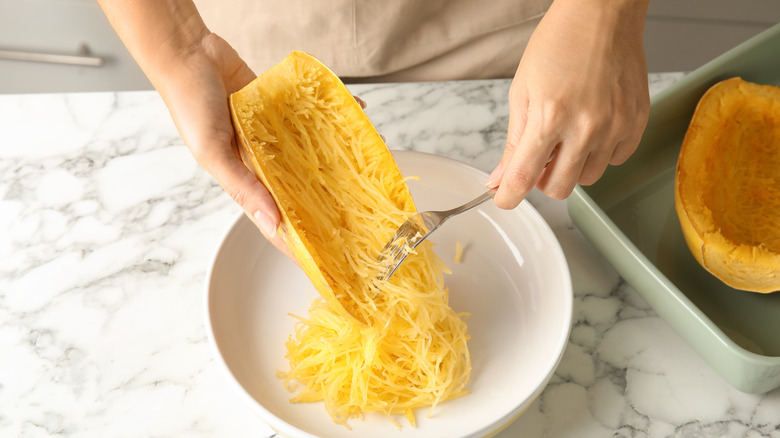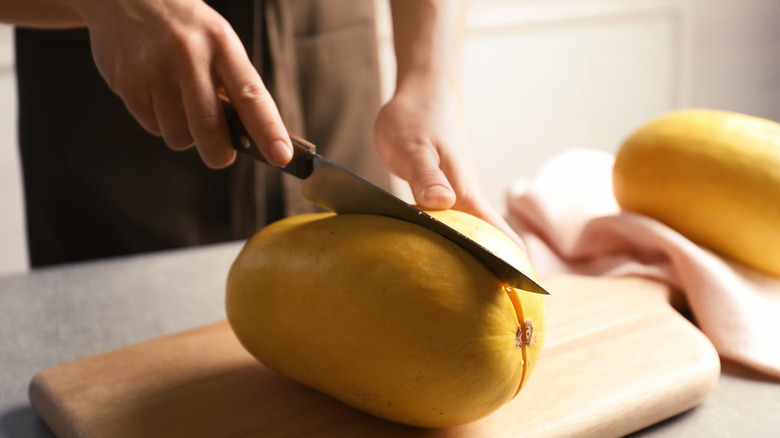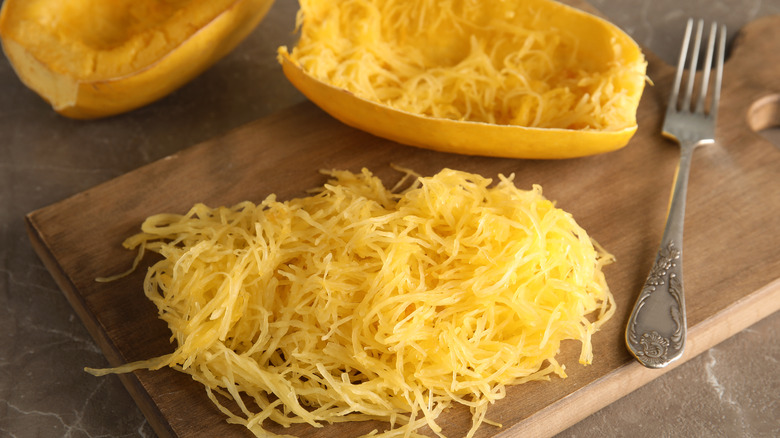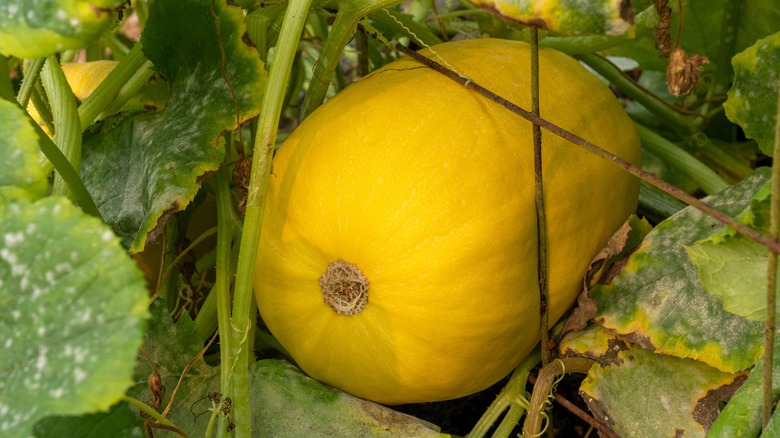10 Tips You Need When Cooking With Spaghetti Squash
For some, the word "spaghetti" conjures up images of Italy. Pasta dishes abound pesto, marinara, and Alfredo sauces perfectly coat al dente noodles that are then piled onto plates. For others, "spaghetti" creates memories of boxed pasta and carb-loaded home meals. Regardless of your personal feelings towards spaghetti, the fact is this thin, stringy pasta is a staple in recipes across the nation. Unfortunately, this staple is an issue for those who have gluten allergies or intolerances as well as those who choose to follow a keto or low-carb diet.
There are alternatives, of course — rice noodles, gluten-free pasta, and black bean pasta come to mind. If none of those strike your fancy, though, there's still the option of the culinary world's versatile hidden secret: spaghetti squash. This bright yellow winter squash isn't your average zucchini. Behind its hard outer shell is a slightly sweet interior that transforms when cooked. As heat breaks down the firm flesh, it becomes stringy and pulls apart into thin spaghetti-like strands which give this squash its name. Its sweet but otherwise unobtrusive flavor makes it the perfect carrier for sauces and toppings. You can use spaghetti squash as a pasta alternative, but don't let its name fool you. There's so much more that this humble gourd can offer if you keep in mind some troubleshooting tips.
Avoid buying squash out of season
Like all vegetables, spaghetti squash grows according to the seasons. However, spaghetti squash is a little more temperamental than its summer cousins. Summer squashes bloom and grow relatively quickly and have thinner skins you can eat whole, whereas winter squashes grow best when it becomes colder. Unlike summer squashes, winter squash can continue to grow to great lengths. This keeps the plants from ruining their flavor or becoming too hard to eat. They all have hard outer skins that provide built-in protection as they grow before they're harvested in autumn.
There are hundreds of different options within the winter squash family, but most are rich and sweet when harvested in season. They have a much longer growing period, around three months, and this extended time makes them sweeter and denser than their summer cousins. Their sweetness makes them ideal for soups and stews, work wonderfully mixed vegetable mashes, and can create excellent preserves when they're canned. Spaghetti squash specifically can be small or large depending on the varietal that farmers plant, and each form of squash has a slightly different flavor. Regardless of their size, the freshest squash of the year arrives in markets and grocery stores in September. This makes sense, as fall is both the perfect sweater and squash weather for us.
Pay attention as you're purchasing
There's nothing worse than going to the grocery store for an ingredient in a new recipe, only to find yourself overwhelmed. Even worse than that is picking the perfect quart of strawberries or a bag of baby spinach and finding them spoiled less than two days later. If you've ever found yourself unable to pick an excellent piece of produce, don't worry. There are a few universal tells that can show your potential squash is perfectly ripe and delicious.
Produce purchased seasonally will always taste better. No matter what time you're buying squash, there are always ways to spot spoilage. According to a guide by Epic Gardening, any squash you pick needs to sound hollow when you thump it with your hand. They should also be uniformly yellow. Any green spots or pale areas can mean the squash hasn't fully ripened. The skin should be dull and matte and shouldn't scratch or break if you try to press your fingernail into it. Be sure to look out for any squash that has cracks in the skin or looks like it's split. Finally, if there is any visible damage, like bruises, mushy skin, or mold, your squash selection is likely overripe and spoiled.
Store your squash correctly
With winter squash, storage might not always be at the front of your mind. It can seem like squash never goes bad and will just dry out further until they turn into decorative gourds. This can be misleading, though, as improperly cured squash will easily spoil. You won't have to worry about curing your squash unless you're growing it yourself. If you're buying your squash from a farmers' market or grocery store, you don't need to worry. More than likely, the farmer has already cured them as part of their harvesting process. The curing process involves setting the squash in a sunny, dry space for a week to 14 days after harvesting to fully dry out the rind.
If you've just purchased your spaghetti squash but don't expect to use it within the next week, there are a few different ways you can store them to prevent spoilage. A root cellar or a cold dark area in your kitchen or pantry works best, but if your modern home doesn't come with an attached earthen basement, you can also refrigerate or freeze your spaghetti squash. Leave it whole or cut it up into more manageable portions and save the raw fruit itself for later cooking. If you've already cooked your squash, you can freeze the cooked strands and reheat them before they've fully defrosted to keep them from getting mushy.
Don't throw out the scraps
If you've ever carved a pumpkin, you know firsthand the waste that squash can produce. If you're not one for composting but loathe the idea of wasting food, have no fear. Pepitas, or roasted pumpkin seeds, have been the saving grace of the eco-conscious every Halloween. Pumpkins may produce the most seeds to roast, but actually, any squash has edible seeds. According to the Institute for Natural Medicine, squash seeds of any kind are excellent snacks, since they're high in protein and omega-3 fatty acids and provide an excellent source of beta carotene and vitamin C.
Spaghetti squash has seeds that are easy to remove from the flesh of the gourd for roasting. After cooking your spaghetti squash, save the roasted skins and the discarded seeds and season them with salt and your preferred spice blend. Toss them both in oil. Roasted skins serve as a deliciously healthy "chip" and homemade seeds work well in trail mixes or homemade energy bars.
If you've ever come across squash blossoms in the garden and mourned the loss of them as the season continues, this could be news to you! The squash blossoms you see are edible themselves! Be careful to only harvest the male squash blossoms if you want to continue using the same plant next year. These delightful edible flowers can be enjoyed raw, or cooked into savory tarts with other deliciously sweet flavors.
You can do more than just roast it
There are hundreds of squash and just as many ways to cook them. Just like butternut squash and delicata squash, spaghetti squash can do well when pan-seared or sauteed. Unfortunately, squash is often relegated to the back of the roasting rack. Certain squashes benefit from specific cooking methods sure, but there's no reason to limit yourself. For spaghetti squash, in particular, almost every recipe you come across recommends baking or roasting the squash to break down the strands of the flesh. If roasting is less your speed because of a lack of time or confidence, there are a few recommended ways to cook spaghetti squash that goes beyond the oven and into the microwave and the convection oven.
Beyond a classic sauteed chunk of squash or pan-roasting your gourd, there are a few more creative options to experiment with. Do you have a spaghetti squash that's lasted until summer? Fire up the grill and try charring lengthwise slabs of the squash. If you're worried about an open heat source or the time it might take to roast or bake your squash, you can try steaming or boiling the gourd to cook the flesh to perfection. If you're in a pinch, and spaghetti squash is the only thing that will sate your cravings, don't worry — microwaving your spaghetti squash is a perfectly reasonable cooking method. Just be sure to prick the rind or cut it in half. You wouldn't want an explosion in your microwave.
Don't forget to oil your squash when you cook it
When you're roasting any vegetable, oil is a must. When you roast a spaghetti squash, you'll want to cut the gourd in halves using a sharp kitchen knife and scoring along the cut line before trying to force the knife through. With the squash cut in halves, oil can help create even browning and a deeper flavor through the Maillard reaction. With the Maillard reaction, sugars in foods such as meats and fruits caramelize with heat. If you were roasting the squash with no oil, the Maillard reaction would still occur, but it would take an extended amount of time and could lead to accidental burning. By oiling the inside and outside of the spaghetti squash, you encourage caramelization of the interior flesh while also keeping the exterior from burning.
While many recommend oiling the entire squash, some believe only the cut sides need to be oiled. Both methods work well, so it really comes down to preference. Thorough oiling is important, but be careful not to add exorbitant amounts — too much can render the squash strands mushy.
Don't skimp on seasoning
Spaghetti squash is notorious for being sweet and mild, but if you're planning on eating it plain, you want to make sure you're seasoning squash well while you cook it. Similar to the pasta itself, the squash is delicious with just salt and pepper, but if you want your squash to pair well with the main course, some simple seasoning blends might be perfect for you. For the simplest option, a classic chicken dish that's either braised or roasted along with the squash is a great combo. Try using the squash to make a stock to cook your chicken in, and season your squash with the same herbs and aromatics you used to season the bird.
As with any recipe, you want to make sure you're using flavors that pair well together. There are several distinct flavor profiles that all spices and herbs fall under. Becoming familiar with what you like, such as sweet cinnamon or earthy bay leaf, can help you become a better chef in the long run. Luckily for our adventurous home chefs, spaghetti squash is ripe for experimentation because of its mild taste. Depending on what you're serving it with, you could play it safe with garlic and thyme. If you're up for the challenge, be adventurous with a Mexican spice blend for a carb-free burrito bowl.
It's got plenty of nutritional benefits
Squash has a plethora of nutrition benefits that are overlooked in favor of its great usage in keto and gluten-free diets.
As mentioned earlier, spaghetti squash is an excellent source of beta carotene. It's also high in folic acid and potassium, which are all important in keeping yourself healthy. Beta-carotene, in particular, is great for the immune system. Medical News Today explains the body processes that beta carotene and converts it into vitamin A. This essential nutrient helps maintain our mucous membranes and immune systems, all of which are essential for not getting sick as the months get colder. According to Healthline, squashes like pumpkin, spaghetti squash, and zucchini are all incredibly nutrient-dense.
Spaghetti squash boasts only 12 carbs per every cooked cup of squash, and within that serving, there are plenty of vitamins and minerals. This squash provides 9% of the daily value of vitamin B-6 and 8% of the daily value of niacin. If you're looking for foods to give you a boost of vitamin C or manganese, spaghetti squash can be a great way to add diversity to your diet while also helping you get a little extra nutrient in your diet.
Don't just eat squash plain
Spaghetti squash makes an excellent substitute for pasta, of course, but just like pasta, it's bland if you eat it plain. There's nothing wrong with eating spaghetti squash, or spaghetti itself, with butter and salt, or simply using it as a delicious side dish in place of your usual starch on the table. If you're open to creating something new, however, there are few vegetables as versatile as spaghetti squash.
You could always go the classic route and incorporate Italian flavors into this gourd. With a name like spaghetti squash, it may seem obvious to load it up with marinara sauce and cheese. For those looking for something a little more involved than just mixing tomato sauce into the squash strands, options abound. Try making lasagna with these low-carb noodle alternatives and add in your favorite vegetables and meats to make a healthy and filling family meal. If you're a fan of letting your starches be the carrier for toppings and flavors you already love, try making a bowl with squash instead of rice. Mixing buffalo sauce into the cooked inside flesh and adding in blue cheese and shredded chicken makes for an easy buffalo chicken bowl.
Vegetarians and squash lovers rejoice. If want to let the flavor of the squash shine, but still want something a little more filling than just plain spaghetti squash, try mixing the roasted squash with brown butter and toasted walnuts for the perfect savory fall dish.
Try growing your own squash
Some farmers and produce purists claim that growing produce fresh will beat out any store, and to some extent, that's true. There's nothing that beats a vine fresh squash warm from the sun. The convenience of picking up a bag of produce from the store certainly comes close. If you want to take your recipes to the next level, growing your squash might be the update you need. You can purchase seeds from any gardening store, but you might consider saving the seeds from your initial crop. If you want to save the seeds from your store-bought spaghetti squash, make sure that you purchase it from a local farmers market rather than a big-name grocery store.
Dry your seeds completely and keep them away from sunlight in a cool, dry place for at least a few days to cure before putting them away for later planting. Squash need to be planted in late spring after the last frost. Spaghetti squash need air circulation to prevent rot and any deformities that may occur from lying against the soft soil. It's also important to water constantly and prune the flowers from your vines toward the end of the growing season. If you're careful and water the fruits often as they're growing, you can ensure that you get full-sized gourds. The bigger your squash gets, however, the more energy they need to continue growing. If large flowers remain on the vine, they take up the most energy trying to produce more fruit.
